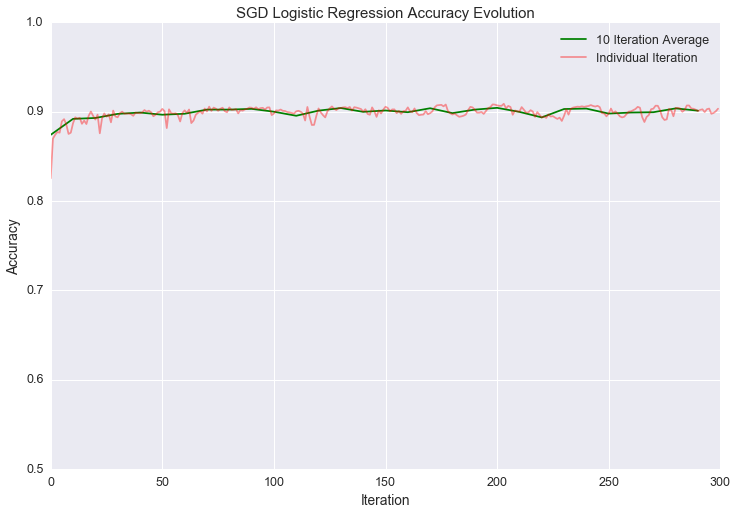Predicting Ratings from 1+ GBs of Yelp Reviews
In a previous post, I used natural language processing techniques to cluster US laws. The dataset was relatively small, and I could easily do all the calculations in memory without frying my computer. But what if the data were larger–so much larger that we either can’t fit in memory or can’t reasonably analyze it in memory. Given the massive amount of data many companies and governments are creating, this is a huge problem (and one that I face at work).
In this post, I’ll walk through out-of-core text analysis, or natural language processing on datasets that are too large to fit or be analyzed in memory. I’m going to try to build a model that can predict whether a Yelp review’s accompanying star rating is positive (4 or 5 stars) or negative (1 or 2 stars).
The data come from Yelp’s Academic Challenge. There are tons of awesome variables in the data (including images, business and user attributes, and user social network data), but for this post I’ll just focus on two: the review itself and the star rating.
Loading the Data
Let’s dive into the Yelp data. It’s about 1.25 gigabytes, so I really don’t want to read that all into my Macbook Air’s memory. I’ll read in 10,000 rows and take a quick look at an example review.
import pandas as pd
import numpy as np
from __future__ import division
import seaborn as sns
import re
import matplotlib.pyplot as plt
%matplotlib inline
reviews_data = pd.read_csv('/Users/nickbecker/Python_Projects/yelp_academic_challenge/yelp_academic_dataset_review.csv',
nrows = 10000)
print reviews_data.iloc[1000, :].text
I've been going here since I was a wee tot. I have always enjoyed their food even though there's nothing too special about it. I really like their breakfast menu. You always seem to get lots of food for very little money, which is nice.
My only complaint is that it is WAY TOO SMALL and always very busy. They should really look at expanding the restaurant.
Okay, so that seems like a pretty good review. They liked the food and the quantity, but didn’t like the size and business of the restaurant. Definitely positive, but probably a 4 star instead of a 5 star since they had some complaints. Let’s check.
print reviews_data.iloc[1000, :].stars
5
Well I was wrong. It’s a 5 star review. This is a perfect of example of why classifying sentiment (or ratings) from text is hard. Fortunately, for this post, I’ll focus on predicting only whether reviews are positive (4 or 5 stars) or negative (1 or 2 stars). This is an easier problem, and is still pretty useful.
Training a Model with Big Data
In other situations, we might read the whole dataset into memory and build a tf-idf or bag of words matrix. In fact, I’ve done that for other text analysis tasks. But here, since the data is so large, our processing and tokenization time would be gigantic even if we could fit everything into memory.
To get around this, we need to change the optimization process. When the dataset size is small, optimization may be fastest by solving directly for the solution. In OLS linear regression, this would be performing the linear algebra to solve for the optimal weights (w = (X’X)-1X’y).
As the dataset becomes larger, gradient descent becomes a more efficient way to find the optimal weights. Gradient descent isn’t guaranteed to find the optimal weights (whether it does or not depends on the shape of the loss or likelihood function space), but in practice we are often fine.
However, as the dataset becomes extremely large, gradient descent becomes less effective. The size of the data just massively increase the number of steps required for gradient descent to converge. To use our massive amount of data, we need a new method.
Stochastic Gradient Descent (or Ascent)
Stochastic gradient descent is the solution. Essentially, we’re going to do the same gradient descent iteratively on random mini-batches of the data and use these to iteratively update our gradient to (hopefully) reach the optimal solution. Again, we aren’t guaranteed to converge to the global optimium (we can get stuck in local optima just like before), but this approach has proven to work extremely well.
As a note, since I’m going to do logistic regression, we’re actually maximizing a likelihood function instead of minimizing a loss function. That makes it gradient ascent, instead of descent.
Preparing the Data
First, I’ll use pandas.read_csv to create an iterator object with chunks of size 1000. With this, I can loop through the iterator and each loop will return a chunk of size 1000 from the dataset until I reach the end. I’ll skip the first 10,000 rows since we already read that into memory and will use that as a validation set.
reviews_iterator = pd.read_csv('/Users/nickbecker/Python_Projects/yelp_academic_challenge/yelp_academic_dataset_review.csv',
chunksize = 1000, skiprows = 10000, names = reviews_data.columns)
Next, I’ll define a function to clean the review text and a tokenizer to stem the words in the review. The tokenizer will be passed to the HashingVectorizer to capture words that should be treated as the same but have different endings.
from nltk.corpus import stopwords
from nltk.stem.porter import PorterStemmer
from nltk import word_tokenize
def clean_review(review):
letters_only = re.sub('[^a-zA-Z]', ' ', review)
words = letters_only.lower().split()
stopwords_eng = set(stopwords.words("english"))
useful_words = [x for x in words if not x in stopwords_eng]
# Combine words into a paragraph again
useful_words_string = ' '.join(useful_words)
return(useful_words_string)
stemmer = PorterStemmer()
def stem_words(words_list, stemmer):
return [stemmer.stem(word) for word in words_list]
def tokenize(text):
tokens = word_tokenize(text)
stems = stem_words(tokens, stemmer)
return stems
I’ll apply our functions to the 10,000 reviews in reviews_data so we can use them as a validation set. I’ll also get rid of the 3 star reviews, as they’re neutral on a 5 star scale.
reviews_data = reviews_data.query('stars != 3')
reviews_data['clean_review'] = reviews_data['text'].apply(clean_review)
reviews_data['star_sentiment'] = reviews_data['stars'].apply(lambda x: 1 if x > 3 else 0)
x_validation = vectorizer.transform(reviews_data['clean_review'])
y_validation = reviews_data['star_sentiment']
Building the Model
Okay, time to build the model. I’ll employ bag of words again, but this time use the HashingVectorizer which lets me create the bag of words successively (which we need in stochastic gradient descent) and avoids filling up my computer’s memory with a big vocabulary dictionary. Then we’ll loop through reviews_iterator to train the model on batches of size 1000 each loop.
from sklearn.linear_model import SGDClassifier
from sklearn.feature_extraction.text import HashingVectorizer
vectorizer = HashingVectorizer(decode_error='ignore', n_features = 2**18,
tokenizer = tokenize, non_negative=True)
y_classes = np.array([0, 1])
max_iterations = 299
clf_logit_sgd = SGDClassifier(loss = 'log', n_jobs = 2, learning_rate = 'optimal',
random_state = 12, verbose = 0, shuffle = True)
validation_accuracy_list = []
for i, mini_batch in enumerate(reviews_iterator):
mini_reviews_data = mini_batch.copy().query('stars != 3')
mini_reviews_data['clean_review'] = mini_reviews_data['text'].apply(clean_review)
mini_reviews_data['star_sentiment'] = mini_reviews_data['stars'].apply(lambda x: 1 if x > 3 else 0)
x_train = vectorizer.transform(mini_reviews_data['clean_review'])
y_train = mini_reviews_data['star_sentiment']
clf_logit_sgd.partial_fit(x_train, y_train, classes = y_classes)
if i % 1 == 0:
validation_accuracy = clf_logit_sgd.score(x_validation, y_validation)
validation_accuracy_list.append((i, validation_accuracy))
print 'Validation Accuracy at {0}: {1}'.format(i, validation_accuracy)
if i >= max_iterations:
break
Evaluating the Model
Let’s see how the accuracy evolved over time. I’ll plot the raw accuracy plot and the average of every 10 iterations.
iterations = [x[0] for x in validation_accuracy_list]
accuracies = [x[1] for x in validation_accuracy_list]
accuracies_average = np.array(accuracies).reshape(-1, 10).mean(axis = 1)
iterations_sampled = [x[0] for i, x in enumerate(validation_accuracy_list) if i % 10 == 0]
y_min = 0.5
y_max = 1.0
sns.set(font_scale = 1.25)
sns.set_style("darkgrid")
f = plt.figure(figsize = (12, 8))
ax = plt.axes()
plt.title("SGD Logistic Regression Accuracy Evolution")
plt.xlabel("Iteration")
plt.ylabel("Accuracy")
plt.ylim(y_min, y_max)
plt.yticks(np.arange(y_min, y_max + .01, .10))
plt.plot(iterations_sampled, accuracies_average, 'green', label = '10 Iteration Average')
plt.plot(iterations, accuracies, 'red', alpha = 0.4, label = 'Individual Iteration')
plt.legend(loc = 'best')
plt.show()

90% accuracy! That’s not bad for minimal pre-processing and a standard logistic regression. If we were smart, we might think that the willingness to give out stars varies across users (or even locations). It makes sense to account for the fact that some people might systematically give mediocre reviews and 4 stars, while others might systematically write fantastic reviews and only give 4 stars. “Normalizing” the features to account for user history would almost definitely improve the model.
Concluding Thoughts and Online Learning
So why might predicting sentiment from reviews be useful? Maybe restaurants would pay for an automated service that tells them when a customer posts about a fantastic or terrible experience at their restaurant. I’d want to make sure to make as few mistakes as possible, so it would make sense to use only the reviews our model classifies above a certain probability of being positive or negative (maybe 95%). This is pretty straightforward with logistic regression.
Restaurants could get that kind of feedback by checking Yelp themselves, of course, but a weekly summary with the highlights and lowlights might save enough time and effort to be worth it.
I only did 300 iterations of stochastic gradient descent. With a chunksize of 1000, that means the model only used 300,000 reviews. By that time, it was pretty clear the classifier was oscillating around 90% accuracy. We could have trained the model by reading in 300,000 reviews and doing a standard gradient descent. Why might the stochastic way be better (aside from being slightly faster)?
It’s better because it lets us do online learning. Online learning is the way we can update our model in near real-time as we acquire more data. Data can come in all the time, and we don’t want to train on the entire dataset every time it changes. Stochastic gradient descent let’s us build our model in small batches and extremely accurately approximate the gradient descent solution. The flexibility of this approach more than makes up for the slightly more involved coding process when you have big and rapidly incoming data.
For those interested, the Jupyter Notebook with all the code can be found in the Github repository for this post.


Leave a Comment